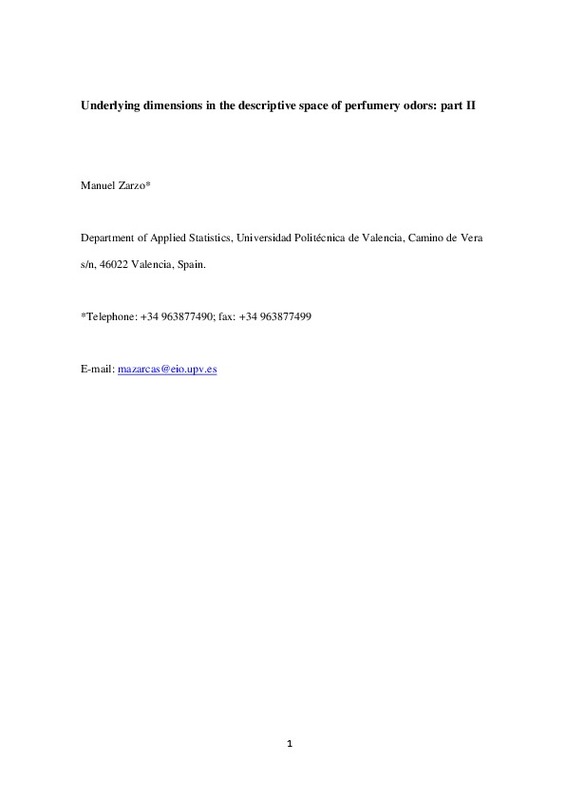JavaScript is disabled for your browser. Some features of this site may not work without it.
Buscar en RiuNet
Listar
Mi cuenta
Estadísticas
Ayuda RiuNet
Admin. UPV
Underlying dimensions in the descriptive space of perfumery odors: part II
Mostrar el registro sencillo del ítem
Ficheros en el ítem
| dc.contributor.author | Zarzo Castelló, Manuel
|
es_ES |
| dc.date.accessioned | 2016-06-13T14:34:21Z | |
| dc.date.available | 2016-06-13T14:34:21Z | |
| dc.date.issued | 2015-07 | |
| dc.identifier.issn | 0950-3293 | |
| dc.identifier.uri | http://hdl.handle.net/10251/65778 | |
| dc.description | NOTICE: this is the author’s version of a work that was accepted for publication in Food Quality and Preference Changes resulting from the publishing process, such as peer review, editing, corrections, structural formatting, and other quality control mechanisms may not be reflected in this document. Changes may have been made to this work since it was submitted for publication. A definitive version was subsequently published in Food Quality and Preference, [Volume 43, July 2015, Pages 79–87] DOI 10.1016/j.foodqual.2015.02.018 | es_ES |
| dc.description.abstract | Some comprehensive compilations of odor character descriptions are available in the literature, and they contain valuable information to better understand the underlying dimensions of human odor psychophysics. In the present study, principal component analysis was applied to two olfactory databases of perfumery materials publicly available, which are comprised by those odor descriptors most frequently used in perfumery. The projection of descriptors over the two principal axes (two-component solution) led to related plots, which are also similar to the one obtained in a previous study (Zarzo, 2008). Although the descriptive space of odors is highly multidimensional, our results suggest that it is possible to reach a consensus about how to project perfumery scents on a two-dimensional map, and how to interpret the dimensions of that sensory map. One of them discriminates light vs. heavy odors; the orthogonal axis was correlated with hedonic tones, but it is better interpreted as an underlying latent structure that distinguishes feminine vs. masculine cosmetic scents. | es_ES |
| dc.language | Inglés | es_ES |
| dc.publisher | Elsevier | es_ES |
| dc.relation.ispartof | Food Quality and Preference | es_ES |
| dc.rights | Reserva de todos los derechos | es_ES |
| dc.subject | Fragrance | es_ES |
| dc.subject | Sensory map | es_ES |
| dc.subject | Olfactory database | es_ES |
| dc.subject | Odor character descriptor | es_ES |
| dc.subject.classification | ESTADISTICA E INVESTIGACION OPERATIVA | es_ES |
| dc.title | Underlying dimensions in the descriptive space of perfumery odors: part II | es_ES |
| dc.type | Artículo | es_ES |
| dc.identifier.doi | 10.1016/j.foodqual.2015.02.018 | |
| dc.rights.accessRights | Abierto | es_ES |
| dc.contributor.affiliation | Universitat Politècnica de València. Departamento de Estadística e Investigación Operativa Aplicadas y Calidad - Departament d'Estadística i Investigació Operativa Aplicades i Qualitat | es_ES |
| dc.description.bibliographicCitation | Zarzo Castelló, M. (2015). Underlying dimensions in the descriptive space of perfumery odors: part II. Food Quality and Preference. 43:79-87. doi:10.1016/j.foodqual.2015.02.018 | es_ES |
| dc.description.accrualMethod | S | es_ES |
| dc.relation.publisherversion | http://dx.doi.org/10.1016/j.foodqual.2015.02.018 | es_ES |
| dc.description.upvformatpinicio | 79 | es_ES |
| dc.description.upvformatpfin | 87 | es_ES |
| dc.type.version | info:eu-repo/semantics/publishedVersion | es_ES |
| dc.description.volume | 43 | es_ES |
| dc.relation.senia | 283192 | es_ES |






![[Cerrado]](/themes/UPV/images/candado.png)


